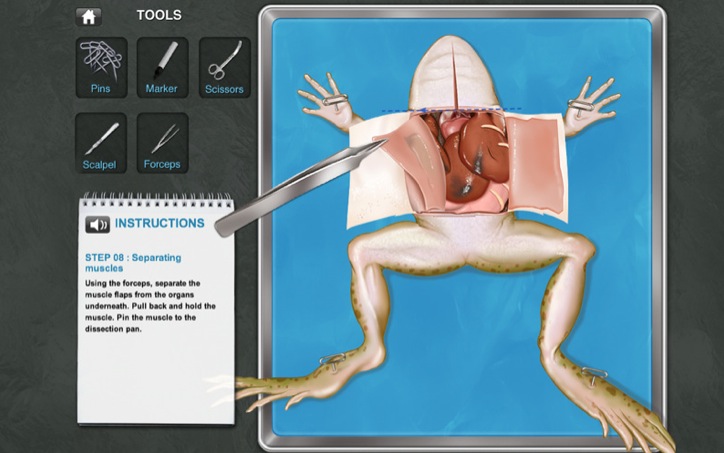- Frog Dissection Miss E. Mac's Classics
- Frog Dissection Miss E. Mac's Classic
- Frog Dissection Miss E. Mac's Class Of
Frog Dissection from Punflay, is a greener alternative for teaching dissection in the classroom. This iPad app is suitable for middle-school students who are learning about organs and organ systems as part of their life science curriculum. A simple dissection of a frog for sixth grade science class. Place a frog on a dissection tray. To determine the frog’s se x, look at the hand digits, or fingers, on its forelegs. A male frog usually has thick pads on its “thumbs,” which is one external difference between the sexes, as shown in the diagram below. Male frogs are also usually smaller than female frogs. A frog dissection is often one of the first labs a biology student has to do. It's a great way to learn about anatomy, physiology, and how amphibians work in general. You can purchase frog dissection kits for the home through companies like Home Training Tools. Kits typically come with the frog, a tray, pins, a scalpel and forceps or tweezers.
Frog Dissection Miss E. Mac's Classics

Well, you knew it had to happen eventually. Your high school student needs to dissect a frog. If you prefer to avoid the mess (and smell, among other things) perhaps this virtual frog dissection will fill the need.
Frog Dissection Miss E. Mac's Classic

Even if you plan to dissect an actual frog, the virtual dissection provides a good review. If you are into notebooking, you can include an experiment worksheet.
Additional Resources
Virtual Frog Dissection
Another option from McGraw Hill.
Frog Anatomy Review Labeling
Labeling worksheet.
Frog Anatomy
Click on each diagram and print for notebook.
Dissecting animals has been a component of thousands of science and biology classes over the years. It’s been a way to study anatomy, internal organs, and other biological components through a hands-on observational approach. It is also a way to make students feel very uncomfortable because their forced to cut into a carcass that may have been specifically killed for study. There may be some advantages to this educational approach, but there are some disadvantages that must be weighed as well.

Here is a look at some of the key points about student animal dissection.
What Are the Pros of Animal Dissection in Schools?
1. It doesn’t have to require an animal for studying any more.
Thanks to modern technology, there are virtual dissections that are available to students. This allows them to study the components of the body in a hands-on way, but through a method that doesn’t kill an animal. They also get to use technology to assist with the studying process, a definite plus for the younger generations. More than a dozen states in the US have laws on the books that protect students’ rights to request virtual alternatives if they don’t want the hands-on approach.
2. Real dissections provide a sensory factor that visual study cannot provide.
Part of the human experience is that most people remember things they can touch or practice doing more than they remember information that they studied. By dissecting an animal in person and touching it, the tactile experiences can provide an overall better learning experience that may help them in future classes if biology or medical sciences will be studied.

3. Regular inspections of biological suppliers happen.
The USDA is required to inspect all biological supply companies. This generates inspection reports that document how animals are being cared for during their presence on site. Sanitation issues, cage construction, and other care issues are addressed by these inspections. Although this doesn’t cover collection methods or how the animals may be killed in order to be provided for dissection, at least it is a regular and expected method of oversight that occurs in the US.
Frog Dissection Miss E. Mac's Class Of
4. Many students don’t complain about animal dissection.
Most students are aware of dissection requirements in school and have no open complaint about the process. Although that’s no guarantee of acceptance, it does indicate that there is an awareness and acceptance of the issue. Many teachers have adopted a debate-style method of conversation before dissection occurs to gauge how students are feeling and if they should proceed with the educational experience.
5. It could be a way to control shelter populations.
There are more than 70 million homeless animals in the United States alone. Some of these are lost companion animals, but a majority of them are either abandoned or never had a home. Instead of being a public taxpayer cost through shelter support, these animals can be sold to provide needed income while also being an educational opportunity. Although ethically challenging, it would be a way to approach the needs of the 10% of medical schools who use animals in their curriculum.
What Are the Cons of Animal Dissection in Schools?
1. It may encourage students to abuse animals.
The simple act of cutting into a dead animal creates a certain resilience within students where they may become comfortable doing the same thing to live animals. It may also cause them to care less about animals, encouraging neglect, abuse, or other forms of cruelty. Many students wind up internalizing their concerns about dissection so they don’t get in trouble with teachers or parents and the only safe place to release this aggression tends to be on other animals.
2. It may stop students from pursuing science any further.
For those students who are uncomfortable and potentially traumatized by the act of dissection, it is possible that animal dissection in schools could stop students from pursuing a science career so they can avoid encountering such a possibility ever again. All life sciences are affected by this. Dissection may be necessary for veterinarian sciences, but exposure at an early age to the process of it may be more harmful to career development than good.
3. We’re talking about millions of animals.
If just frog dissection is being considered, there are approximately 6 million animals that are provided to students for study every year in the United States alone. Now add in the rats, mice, and other animals that are also provided for dissection and the total number of animals studied annually can reach 8 figures. This puts a premium price on animal life that some people are just not comfortable placing. Many students report that after they cut the animal up, they don’t remember learning anything about it anyway. They just remember that they were forced to cut up an animal.
4. It may desensitize students from the concepts of animal testing.
There are animals that are specifically born and bred for experimentation. Only 5% of animals that are used for experiments of any kind are protected by the Animal Welfare Act that Congress passed. Although testing and dissection is often about frogs and mice, there were more than 6,000 dogs used for testing, nearly 7,500 chimpanzees, and even 2,700 cats. For those who have to process these animals, it is not uncommon for a severe hatred of them to develop simply because they are exposed to so much death.
Putty for mac brew. 5. There are few foreign control measures in place to determine how the animals were obtained.
In a 1994 Mexican raid on a chicken farm, more than 1,000 cats had been found killed in a barn on the premises. Their throats had been slit, leaving blood all over the place. A bounty from the company gave people $1 per cat that was given to them. All of the cats were destined for dissection in classrooms in the United States. Since there are no real control measures in place and little oversight, there is no way to determine how the animal was obtained and killed so that it could be studied. Dealers only need to be inspected once per year.
The pros and cons of animal dissection in schools show that this sensitive subject should be addressed on a personal level. Far more harm than good tends to happen, so those students who are uncomfortable with the process should be identified and removed from the requirement. Dissection is often seen as a cheap and cruel way to treat an animal. With virtual teaching methods available just a click or two away on the internet, there are always options that do not involve cutting open a dead animal for the sole purpose of education.
There are two versions of Abelssoft MyKeyFinder: free and paid-for.Both will find Windows and Microsoft Office product keys but the Plus edition (£8.90 – about US$10, AU$15) will also scan. APKF Product Key Finder or Adobe Product Key Finder is a free tool that helps you to track any missing product keys or serial numbers for nearly any products offered by Adobe like, Photoshop, Creative Suite CS6, CS5, Cs4, Cs3, Acrobat Reader, Flash and more. Top 14 Best Free Product Key Finder for Windows 10. As you know, losing your Windows product key means you’ll miss out on all the Windows updates, latest features, and premium products, that will basically result in purchasing the product again. Here are 27 best free product key finder software. These product key finders let you find the CD-Keys of the installed Microsoft Products like Windows Operating System, MS Office as well as Non-Microsoft products. All these product key finder software are available free to download for your Windows PC. Best free product key finder. The product key is what technology companies employ to inhibit the theft of their product. To help get you up and running again, we have compiled a list of the best product key finders available.
